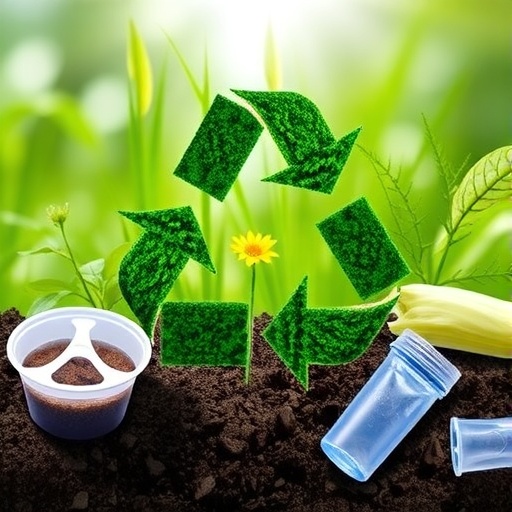In a groundbreaking study conducted by researchers Basit et al., published in Discover Sustainability, the complexities surrounding the biodegradability of bioplastics have been meticulously unraveled. As the global plastic crisis escalates, the push for sustainable alternatives such as bioplastics has gained momentum. However, myths and misconceptions about their environmental performance and degradation timelines abound, leading to a pressing need for clarity in understanding their true impact on ecosystems.
The research delves deep into the various types of bioplastics, which are broadly categorized into bio-based, biodegradable, and compostable materials. Bio-based plastics are sourced from renewable biological resources, while biodegradable plastics can be broken down by microorganisms under specific conditions. Compostable plastics, a subset of biodegradable plastics, are designed to decompose into non-toxic components in a composting environment. Yet, confusion persists among consumers and industries alike regarding how these materials actually break down and under what circumstances.
One significant revelation from the study is the variability in degradation rates among different bioplastics. A common belief is that all bioplastics biodegrade rapidly and efficiently, but this is a misconception. The study reveals that the biodegradability of bioplastics is highly contingent on the environmental conditions they are exposed to, including temperature, humidity, and the presence of microorganisms. For instance, some bioplastics may take months to decompose in industrial composting facilities, while others might persist for years in marine environments.
Moreover, the researchers highlighted the lack of standardized testing methods to evaluate bioplastic biodegradability. Current assessments often do not reflect real-world conditions, leading to inflated expectations about the performance of these materials in natural habitats. The findings underscore the necessity for regulatory frameworks that enforce rigorous testing standards, ensuring that claims of biodegradability are substantiated by scientific evidence.
The study further emphasizes the ecological implications of improper disposal of bioplastics. Contrary to popular belief, tossing biodegradable plastics into regular waste bins does not guarantee their breakdown in landfills, where oxygen and moisture are limited. The accumulation of such materials in landfills can contribute to long-lasting environmental issues. Hence, proper disposal methods and public education on waste management are critical components in addressing the environmental drawbacks associated with bioplastics.
Importantly, consumer perception plays a vital role in the success of bioplastics as an alternative. The researchers found that many consumers operate under the false assumption that all bioplastics are eco-friendly. This misconception can lead to irresponsible usage and disposal practices. Educating consumers about the distinct types of bioplastics and their proper treatment is essential for maximizing their environmental benefits.
Additionally, the availability of bioplastics raises questions about resource allocation. It is crucial to ensure that the agricultural resources used to produce bioplastics do not compete with food production. The researchers call for a balanced approach that considers the social and environmental dimensions of bioplastic production, urging manufacturers to invest in sustainable sourcing practices.
Amidst these challenges, the potential benefits of bioplastics cannot be overlooked. When correctly disposed of, bioplastics can alleviate some of the pressures exerted on fossil fuel-derived plastics. The researchers advocate for innovative solutions, such as blending bioplastics with other biodegradable materials, to enhance degradation rates and reduce environmental impact.
The study contributes significantly to the growing body of literature surrounding bioplastics. It not only separates fact from fiction but also presents a clear pathway forward for researchers, manufacturers, and policymakers. By fostering an environment of transparency and education, the research aims to pave the way for sustainable practices that genuinely benefit our planet.
As society continues to grapple with the implications of plastic pollution, the insights provided by Basit et al. serve as a vital resource for informed decision-making. The future of bioplastics hinges on our collective understanding and responsible management of these materials. Without a concerted effort to debunk myths and educate the public, the promise of biodegradable plastics may remain unfulfilled, leaving lingering questions about their role in a sustainable future.
In conclusion, the journey toward sustainable plastics requires clarity, commitment, and collaboration among all stakeholders. From researchers to consumers, everyone has a role to play in ensuring that bioplastics realize their potential to serve as effective solutions in combatting the plastic waste crisis. The findings of this study spotlight the urgency of addressing misconceptions, implementing regulatory standards, and fostering a culture of environmental responsibility in the realm of bioplastics.
By taking these steps, we can harness the advantages of bioplastics while mitigating the risks associated with their mismanagement. This research calls for a new narrative around bioplastics, one that emphasizes informed choices and sustainable practices, ultimately contributing to a healthier planet for future generations.
Subject of Research: Biodegradability of Bioplastics
Article Title: Separating facts and fictions for biodegradability of bioplastics
Article References:
Basit, M., Saleem, A., Zehra, S.M. et al. Seperating facts and fictions for biodegradability of bioplastics. Discov Sustain 6, 947 (2025). https://doi.org/10.1007/s43621-025-01062-7
Image Credits: AI Generated
DOI: 10.1007/s43621-025-01062-7
Keywords: Bioplastics, biodegradability, environmental impact, sustainable practices, consumer education.




